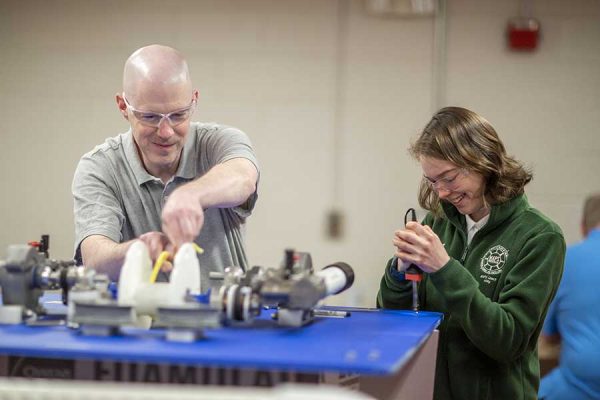Wes Williams: The low down on wave energy technology

Wes Williams is an associate professor of mechanical engineering technology in The William States Lee College of Engineering at UNC Charlotte. He is leading a team of researchers composed of students, alumni and external partners — self-titled WATER BROS (Wave-Actuated Tethered Emergency Response Buoyant Reverse Osmosis System) — to develop wave-energy solutions for coastal and island communities affected by loss of electrical power from natural disasters, and similar applications. In spring 2022, WATERBROS finished second in the U.S. Department of Energy’s Waves to Water competition, a three-year, $3.3 million competitive process that encouraged and supported participants to design, build and test devices that use wave energy to produce clean drinking water from ocean water.
Why do ocean waves hold promise as a renewable energy source?
With a large portion of the world’s population located near coastal areas, wave energy is a local resource. It is available 24 hours a day and can be more consistent than solar or wind energy. There is actually a nice synergy between wave energy and solar in that seasonally the best periods for wave energy coincide with the weakest for solar energy and vice versa. Having both on the grid would provide reliable renewable energy year-round.
What is the key to unlocking the potential of this technology?
The ocean is a very dynamic environment that can change quite quickly and devices that are in the water need to be robust and adaptable to not only survive in those conditions but to thrive in them. Improved simulations and characterization of the wave environment are important, but those will ultimately need to be proven out with long term deployments in the open ocean.
How is UNC Charlotte’s Waves to Water team, WATER BROS, contributing to what is known about wave energy?
By getting deployable, lightweight, robust devices into the open ocean for testing, Water Bros is helping to build experience with the installation, operation, maintenance, and retrieval of wave energy devices. In addition to the science and engineering going into the devices, these lessons learned during deployments will be critical to developing wave energy devices that can be competitive in terms of cost. Finding ways to harness wave energy, while keeping the operations and maintenance costs low, is key to commercializing the technology.
In what ways are UNC Charlotte and The William States Lee College of Engineering supporting your team’s ongoing research?
First off, the university has provided a great pool of talent to drive this project forward. I’m so proud of the students and alums who have contributed to the Water Bros team throughout the competition. As the only university team in the finals, I think the other teams and the competition administrators were impressed with the caliber of our students and graduates. Administratively, the College of Engineering’s Industrial Solutions Laboratory was a nimble, flexible partner for our small business. They provided an easy way to access the lab space we needed in the CREATE and DRINK stages and hire the students. Finally, the College of Engineering’s participation in the North Carolina Renewable Ocean Energy Program (NCROEP) over the years has given me access to leaders in the marine energy field that I otherwise may never have met. Insights from those being around those leaders gave us a leg up when we tackled this, our first wave energy project. The NCROEP is also where I met Landon Mackey, my Water Bros business partner.
What’s next for WATER BROS as the team continues its post-Waves-to-Water success?
The team is actively looking at some follow-on funding opportunities to get a device back into the water. We will be presenting our research at the Marine Energy Technology Symposium in Portland, Oregon, this fall as well as the International Conference on Ocean Energy in Spain. These conferences provide opportunities to learn from and collaborate with the leaders in the field of marine energy.